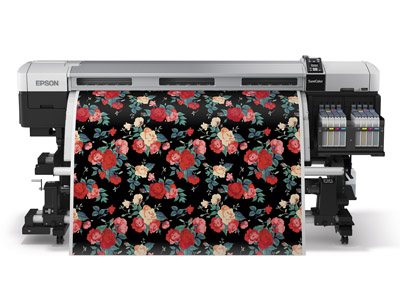A striking shirt – Roland’s Texart inks include fluorescent yellow and pink
The textile printing market is growing rapidly, largely driven by the garment market. But what do printers need to get into this sector? Nessan Cleary finds out.
In last month’s issue, we looked at printing onto textiles for soft signage. But the biggest slice of the textile market is printing directly to garments. There is some crossover between the two, mainly around workwear, with many wide format printers also producing hats and tee-shirts with company logos. The soft furnishings market, which includes everything from curtains to duvet covers and cushions is also closely related.
Again, many wide format printers are also producing things like curtains and cushions in corporate colours for reception areas, as well as wall hangings to match. There are two big issues that anyone looking at investing in this area should consider. The first is the different processes that are needed, typically printing, fixing the inks and washing the fabrics, followed by cutting out the item and sewing it. The degree of complexity varies with the type of material. Display graphics, for example, are usually printed to polyester materials with water-based inks, which is the easiest to cope with. There are plenty of polyester-based materials available for different garments, but some may require more specialist fabrics such as cotton or silk, each with their own ink and handling characteristics. The second thing to consider is volume. It is one thing to print ten t-shirts for a local builder, but quite another to produce a thousand dresses for a large retailer. Depending on the actual fabric product, it can be harder to automate some of the processes, particularly the sewing. But the volume of work and the overall productivity will determine the profit margin and viability of the business.
Transfer papers
There are a number of wide format printers that use water-based dye sublimation inks to print to a lightweight transfer paper. The paper is then pressed against a textile in a heat press or calendar that heats the ink up almost to a gaseous form, driving the pigment deep into the fibres of the fabric. The material retains its own feel and is washable. This method also works well with stretchy materials and is particularly cost effective for producing sportswear. Epson has developed the SureColor F-series of dye sub printers, which all print to transfer paper. The top of the range is the SC-F9200. This is a 1.6 m wide printer capable of producing 56 sqm/hr in Production mode. It uses two Epson PrecisionCore printheads combined with Epson’s UltraChrome DS sublimation ink.

Coming up roses – Epson’s 1.6 m width SureColor F9200 uses UltraChrome DS
There’s a slower version, with a single printhead, the F7200, and a smaller 1.1 m wide F6200. Epson recently teamed up with fashion designer John Herrera to produce a 30-piece collection on Epson’s dye-sublimation printers for London Fashion Week in February. Herrera explained that printing the textiles digitally drastically reduces the amount of wasted fabric, ‘With digital textile printing, we only use the exact volume of fabric. Instead of wasting five yards of fabric to do a lay out for a dress, we use only one and a half yards of digitally printed fabric.’
A number of companies supply third party dye sublimation inks for Roland printers but Roland itself also makes the Texart range of printers. There are two models, both 1.6 m wide, with the XT640 being the faster. It can produce up to 63 sqm/hr and comes with an Ergosoft RIP for textiles. There is a choice of four or eight colour inksets, using Roland’s Texart inks, which also include fluorescent pink and yellow options for sportswear. Mutoh sells a number of printers designed to print to transfer paper. This includes the recently launched ValueJet 1948WX, which now boasts four printheads and can produce up to 117 sqm/hr. There is also a 1.6 m version, the 1638WX. Mutoh also makes the ValueJet 1938T, a 1.9 m wide direct to textile printer. It uses water-based pigmented inks to print direct to cotton, silk, rayon and mixed fibre materials without requiring any washing or steaming post-treatments. However, you will still need a separate fixation unit to cure the inks.
Mimaki has been one of the pioneers of wide format textile printing, having developed a number of dye sublimation printers. Amongst its latest offerings is the TS500P, a 3.2 m wide roll fed machine for producing home furnishings and display graphics via transfer paper. It prints 105 sqm/hr in its Standard mode. There is a similar machine, the TX500P, which includes a built-in infrared fixation unit for printing direct to textiles. It is aimed at various uses including fashion and sportswear and interior decoration. It can produce 1.5 sqm/hr in Standard print mode with four colours, which drops to around 50 sqm/hr for six colours with a slightly higher resolution. Durst sells the Alpha 180TR, a heavy-duty printer designed for industrial scale production using transfer papers. It can produce around 200 sqm/hr across a printing width of 1.85 m. It offers resolution up to 1200 dpi with a four-colour dye sublimation inkset. It is aimed at the soft signage, clothing and home furnishings markets, using polyester-based materials.
—
Read the full feature here





